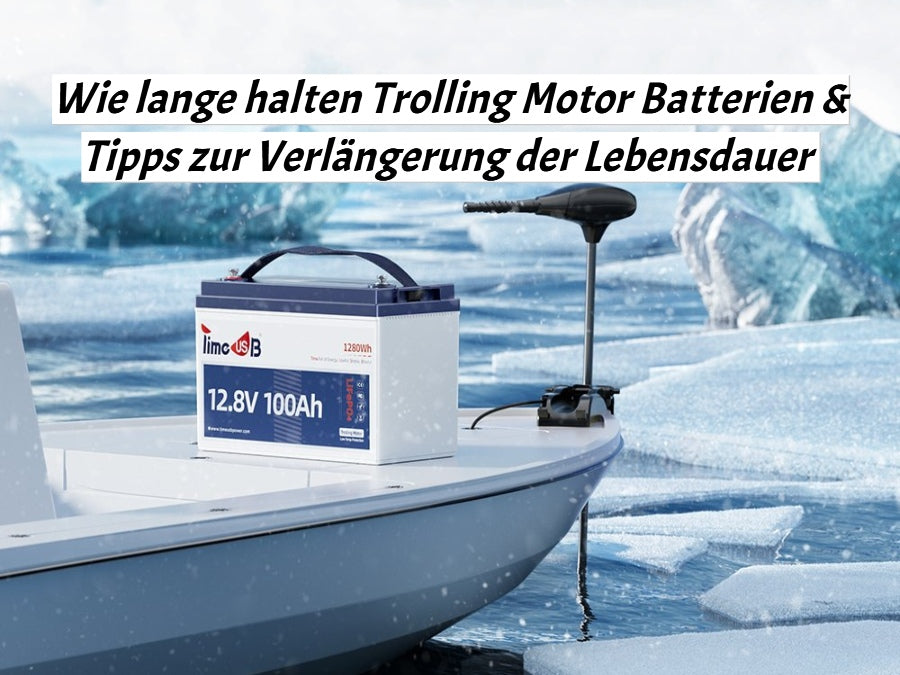[Latest] How to Charge LiFePO4 Battery – Timeusb
![[Neuest] So Wie man lädt LiFePO4 Batterie auf – Timeusb](http://timeusbpower.de/cdn/shop/articles/200Ah_Timeusb_LiFePO4_Akku_Lithiumbatterie_Solarbatterie.jpg?v=1702536902&width=1600)
One of the most common questions we get from our customers is how to charge LiFePO4 battery. The answer is simple: use a LiFePO4 battery charger specifically designed for that battery type. Avoid using chargers designed for other lithium-ion chemistries, which typically have higher voltages than LiFePO4 requires.
We are sometimes asked if lead acid battery chargers can be used to charge lithium iron phosphate and the answer is not recommended.
In this article, we'll tell you why charging a LiFePO4 battery with a lead-acid charger is not recommended, and we'll know the three best ways to charge a LiFePO4 battery. Let's dive in.
Why charging LiFePO4 batteries with a lead-acid charger is not recommended
LiFePO4 battery charging logic
First, let us know the charging logic of the LiFePO4 battery.
Due to the material properties of LiFePO4 battery, its charging curve is obviously different from that of lead-acid battery. Compared with lead-acid battery, LiFePO4 battery has simpler charging process and mode. Therefore, it is recommended to select LiFePO4 as the charging mode.


LiFePO4 charging mode
Take, for example, the Timeusb 12V 100Ah LiFePO4 battery.
CC phase (constant current) (T1)
Initially, a discharged battery is charged with a constant current and the voltage increases steadily until the constant voltage setpoint is reached, which varies depending on the charging method.
CV phase (constant voltage) (T2)
The battery maintains a constant voltage during this phase while the current gradually decreases to 2A (0.02C), also known as tail current. At this point, charging stops and the battery is fully charged.
Tail current (A) = battery capacity * 0.02C. Example: 100Ah * 0.02C = 2A tail current.
Charging a LiFePO4 battery with a lead-acid charger is not recommended for several reasons:
- Tension: Lead-acid and LiFePO4 batteries have different voltage requirements. LiFePO4 batteries typically have a nominal voltage of 3.2-3.3 volts per cell, while lead-acid batteries have a nominal voltage of 2.0 volts per cell. Using a lead-acid charger could overcharge the LiFePO4 battery and possibly cause damage.
- loading algorithm: Lead-acid chargers use a different charging algorithm than LiFePO4 batteries. LiFePO4 batteries require a special charging algorithm to prevent overcharging and maximize battery performance and life. Using a lead-acid charger with the wrong charging algorithm can result in improper charging and shortened battery life.
- Security: LiFePO4 batteries have different safety requirements than lead-acid batteries. Using a lead-acid charger could potentially overheat or damage the LiFePO4 battery, which could lead to safety risks, including the risk of fire or explosion.
To ensure optimal performance, safety and longevity of LiFePO4 batteries, it is recommended to use a charger specifically designed for LiFePO4 batteries solar and that meets the correct charging algorithm and voltage requirements.
3 Best Ways to Charge LiFePO4 Battery
1. Charge the LiFePO4 battery with the lithium iron phosphate battery charger
Charging LiFePO4 solar battery with a lithium iron phosphate battery charger (LiFePO4) is the most optimal method for several reasons.

First, these chargers provide precise voltage and current control during charging to prevent overcharging, which can damage the battery and shorten its lifespan.
Second, LiFePO4 battery chargers end the charge cycle at the recommended cut-off voltage of about 3.6-3.65 volts per cell, extending battery life. Third, cell balancing technology ensures even charging of all cells, reducing imbalances that negatively impact performance and longevity. Fourth, temperature sensors monitor the temperature of the battery during charging, allowing adjustments to be made to ensure safe charging and prevent overheating.
Finally, LiFePO4 battery chargers are compatible with battery management systems (BMS), ensuring that the battery remains protected during charging.

In conclusion, using a LiFePO4 battery charger enables efficient and safe charging of LiFePO4 batteries with precise voltage and current control, automatic charge termination, balancing technology, temperature monitoring and compatibility with BMS systems, all of which help maintain the performance of the battery and extend its overall lifespan. Therefore, such chargers are highly recommended for charging LiFePO4 batteries.
2. Using an alternator (and a DC-DC charger)
An excellent charging solution for RVs and boats with battery storage is to use an alternator to charge LiFePO4 batteries.
An alternator is a generator that converts mechanical energy into electrical energy, producing alternating current (AC). The connected rectifier then converts the alternating current into direct current (DC).
It is an essential part of the electrical system of any internal combustion engine vehicle and is responsible for charging the starter battery used to start the engine. With some modifications, this electrical system can also be used to charge a battery bank, including LiFePO4 batteries, while the vehicle is running.

LiFePO4 batteries have a low internal resistance when not fully charged, which means they can draw any amount of current from the alternator, which can lead to overheating and damage to the battery.
To avoid these problems, a DC/DC charger limits the generator's current draw, thus avoiding overheating. It also regulates the output voltage to match the LiFePO4 battery's required charging voltage, thus preventing overcharging and ensuring safe and efficient charging.
3. Charging the LiFePO4 battery with solar panel
It is not only possible but also highly recommended to use a solar system to charge LiFePO4 batteries.This is because solar panels generate the energy needed for charging rather than getting it from another energy source such as shore power.
Things you need for solar panel charging.
- Solar modules: Solar modules convert the energy of sunlight into electrical energy, which is controlled by a charge controller according to the charging needs of the battery.
- charge controller: A charge controller is essential to regulate the charging process and prevent overcharging or undercharging the LiFePO4 battery. Make sure you use a charge controller specifically designed for LiFePO4 batteries to ensure compatibility.
- Batteries: The battery stores the energy generated by the solar modules as chemical energy.

How to charge your LiFePO4 batteries in parallel and in series
To ensure safe and efficient charging, parallel or serial charging of LiFePO4 batteries requires special considerations. Here is a summary of how to charge your LiFePO4 batteries both parallel and in series can load:
Parallel charging of LiFePO4 batteries
Connect all the positive terminals of the battery and then the negative terminals together to form a single battery pack.
Charging LiFePO4 batteries in parallel or series requires careful consideration to ensure safe and efficient charging. It is important to use a charge controller specifically designed for lithium batteries to connect the battery to the charger to regulate the charging process and prevent overcharging, while balancing the voltage on each battery.
It is recommended to monitor the charging process regularly to ensure that the charge controller maintains a stable charge rate for all batteries in the pack. Once the batteries are fully charged, disconnect them from the charger to avoid damage.
For optimal performance and longevity of your lithium batteries when connected in parallel, it is recommended that you charge each battery individually before making the parallel connection(s). After charging, use a voltmeter a few hours later to check the voltage of each battery and make sure they are within 50mV (0.05V) of each other before connecting them in parallel. This procedure minimizes the chance of an imbalance between the batteries, thus improving system performance.
Over time, it is possible that the battery bank capacity will decrease. If this happens, disconnect the parallel connections and charge each battery individually before reconnecting them. This action will help to equalize the battery voltages and restore the battery bank capacity.
Charging LiFePO4 batteries in series
When connecting lithium batteries in series, it is best to follow a similar approach to connecting them in parallel. By charging each battery individually and checking the voltage to ensure they are within 50mV (0.05V) of each other before connecting them in series, you can minimize imbalances between the batteries and promote optimal performance. This approach ensures that the batteries are charged as evenly as possible, maximizing their capacity and extending their overall lifespan.
Here are the steps you need to follow when charging LiFePO4 batteries in series:
- Connect the positive terminal of one battery to the negative terminal of another battery until you have connected all of the batteries in series, creating a higher voltage battery pack.
- Use a charge controller specifically designed for lithium batteries with a rating suitable for the total voltage of the battery to connect the battery to the charger.
- Monitor the charging process regularly to ensure that the charge controller maintains a stable charge rate for the entire battery.
- Disconnect the battery from the charger once it is fully charged.
A notice: It is important to balance the voltages between each battery during charging to avoid imbalances that could result in reduced performance and shorter lifespan. Make sure the charge controller has cell balancing capabilities or use a separate cell balancer to ensure each battery receives the same amount of charge. By following these steps, you can charge your LiFePO4 batteries in series safely and efficiently while promoting optimal performance and longevity.
More frequently asked questions about charging LiFePO4 batteries
1. How to charge LiFePO4 battery in cold weather?
Here are some tips for charging LiFePO4 batteries in cold weather.
By following these tips, you can safely and efficiently charge your LiFePO4 battery in cold temperatures, optimize its performance, and extend its overall lifespan.
2ndShould I fully charge my LiFePO4 solar battery?
When using your LiFePO4 battery, it is recommended that you fully charge it before each use. This will ensure that you have maximum capacity available for your application and that the battery performs optimally.
However, for long-term storage, it is generally recommended that LiFePO4 batteries be stored at a 50% state of charge (SoC). Storing the battery at this SoC will help prevent self-discharge and minimize the degradation that can occur over time. It is also important to regularly check the battery's state of charge during storage and recharge it if the SOC drops too low to ensure its health and longevity. Learn more about how to properly store your LiFePO4 battery.
It should be noted that specific recommendations may vary depending on the manufacturer and battery model, so it is always a good idea to consult the battery's user manual or check with the manufacturer for specific charging and storage guidelines.
3. Can LiFePO4 batteries be completely discharged?
LiFePO4 batteries can be fully discharged, but this is generally not recommended. Fully discharging a LiFePO4 battery can cause irreversible damage and significantly reduce its lifespan. It is recommended to avoid discharging the battery below 20% or below the recommended cut-off voltage. Regularly fully discharging a LiFePO4 battery can lead to capacity loss and reduced performance over time. It is best to charge the battery before it reaches a critically low charge level to ensure its longevity and optimize its capacity.
4. When should I charge my LiFePO4 battery?
In general, it is recommended to charge a LiFePO4 battery when its state of charge (SOC) drops to about 20-30%.

Conclusion
Therefore, to achieve optimal performance and extend the life of LiFePO4 batteries, it is important to follow the correct charging procedures. We have presented three ways in this article, with the use of a lithium iron phosphate battery charger being the most recommended.
Timeusb offers high quality, affordable LiFePO4 batteries with Class A cells. Our range also includes LiFePO4 battery chargers to ensure your battery stays in optimal condition. If you have any questions or need assistance, please contact customer service at service.de@timeusbpower.com. We are always ready to help you.




